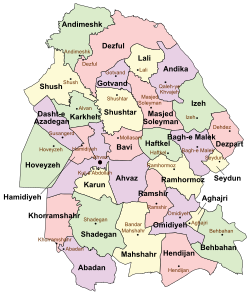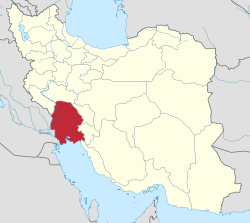Top Qs
Timeline
Chat
Perspective
Izeh County
County in Khuzestan province, Iran From Wikipedia, the free encyclopedia
Remove ads
Izeh County (Persian: شهرستان ایذه) is in Khuzestan Province, Iran. Its capital is the city of Izeh.[3]
Remove ads
History
After the 2006 National Census, Susan-e Gharbi and Susan-e Sharqi Rural Districts were separated from the Central District in the formation of Susan District.[4]
In 2021, Dehdez District[a] was separated from the county in the establishment of Dezpart County.[5]
Demographics
Summarize
Perspective
Ethnicity
The vast majority of its population is from the Bakhtiari tribe, one of the largest in Iran.[citation needed]
Population
At the time of the 2006 census, the county's population was 193,510 in 36,123 households.[6] The following census in 2011 counted 203,621 people in 45,090 households.[7] The 2016 census measured the population of the county as 198,871 in 48,682 households.[2]
Administrative divisions
Izeh County's population history and administrative structure over three consecutive censuses are shown in the following table.
Remove ads
Geography and climate
Izeh County is the highest county in Khuzestan province, with an average elevation exceeding 1,000 meters. Its climate differs from the rest of the province, being cooler and more humid. Annual rainfall ranges from 580–740 mm in Margha Station to over 750 mm in the forested valleys near Dehdez.[citation needed]
Tourism
Izeh County is a major hub for ecotourism in Khuzestan, attracting the highest number of visitors among the province's counties.[9]
The statue of the Parthian nobleman discovered in the Izeh region, often referred to as the "Shami man," is a notable artifact associated with the Parthian period. The statue is celebrated for its craftsmanship, reflecting the artistry and cultural influences of the time. The figure, possibly representing a Parthian aristocrat or a deity, provides insight into the attire and aesthetic sensibilities of the era.[9]
See also
![]() Media related to Izeh County at Wikimedia Commons
Media related to Izeh County at Wikimedia Commons
Notes
- Renamed the Central District of Dezpart County[5]
- Formerly Donbaleh Rud Rural District[8]
References
Wikiwand - on
Seamless Wikipedia browsing. On steroids.
Remove ads



